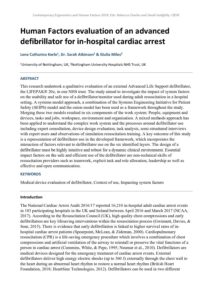| Document | Author Lena Catharina Kerle, Dr. Sarah Atkinson & Giulia Miles |
| Abstract This research undertook a qualitative evaluation of an external Advanced Life Support defibrillator, the LIFEPAK® 20e, in one NHS trust. The study aimed to investigate the impact of system factors on the usability and safe use of a defibrillator/monitor used during adult resuscitation in a hospital setting. A systems model approach, a combination of the Systems Engineering Initiative for Patient Safety (SEIPS) model and the onion model has been used as a framework throughout the study. Merging these two models resulted in six components of the work system: People, equipment and devices, tasks and jobs, workspace, environment and organisation. A mixed methods approach has been applied to understand the complex work system and the processes around defibrillator use including expert consultation, device design evaluation, task analysis, semi-structured interviews with expert users and observations of simulation resuscitation training. A key outcome of this study is a representation of defibrillator use in the developed framework, which incorporates the interaction of factors relevant to defibrillator use on the six identified layers. The design of a defibrillator must be highly intuitive and robust for a dynamic clinical environment. Essential impact factors on the safe and efficient use of the defibrillator are non-technical skills of resuscitation providers such as teamwork, explicit task and role allocation, leadership as well as effective and open communication. |

